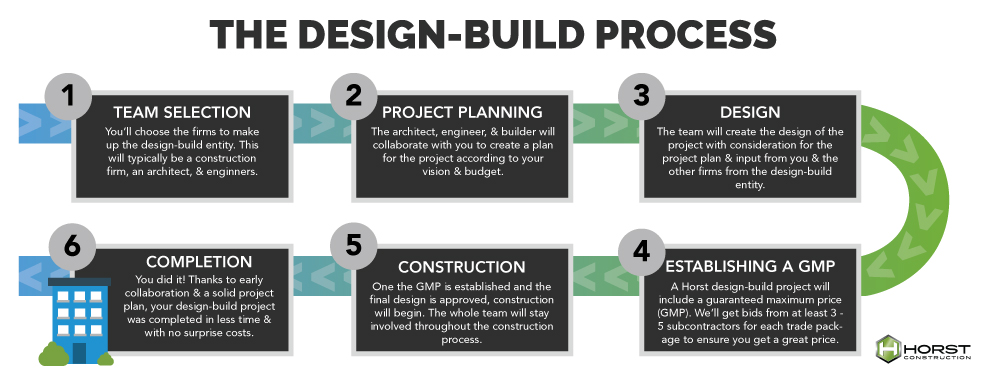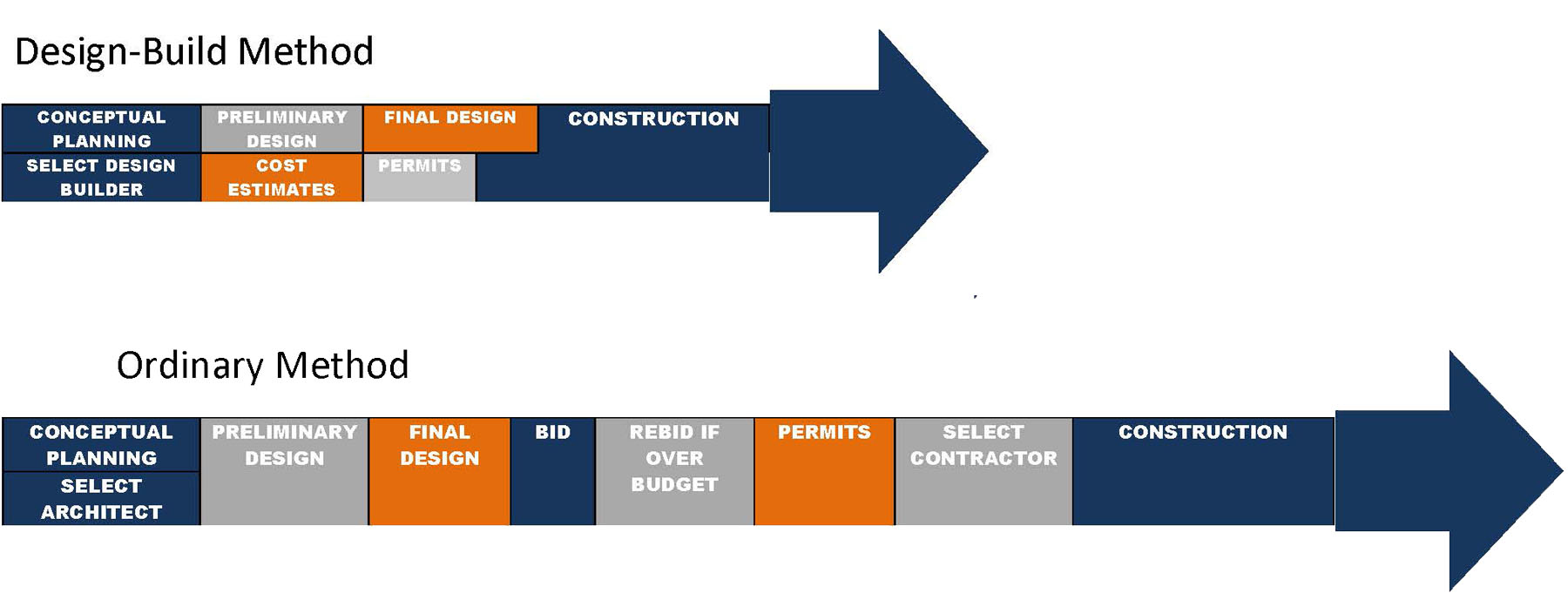Construction Basics for Owners: The Design-Bid-Build and Design-Build Delivery Methods
Table Of Content

Despite the risks, many owners still prefer DBB to any other delivery method because it's simple and may deliver the project at a lower cost. Owners also enjoy more control over the process than they may get with other project delivery methods. While both design-bid-build and design-build rely on input from the project owner, traditional project delivery gives you much more command throughout the process. Aside from getting to choose your own designer and contractor, you have the freedom to make personnel changes mid-project without having to start from the beginning again. When it comes to design build vs design bid build, let the project specifics be your guide to selecting the most appropriate delivery method.
#1 Source for Construction News, Data, Rankings, Analysis, and Commentary
With no bidding process, the project owner does not have the ability to select their own price. Plus, most design-builders will not begin any detailed design of a building until they have been officially hired, making it hard to price shop for a design-builder. With the design and construction performed by one group, the risk of issues is reduced. The construction team has input throughout the design process and the design team is readily available to address any building issues that come up during construction. It is also a straightforward, sequential process with one task following the completion of the one preceding it. First is the design phase, where the owner negotiates for the architect/engineering firm’s services to develop the project design.
No ownership of problems
Design-Build: An Alternative Construction System - Legislative Analyst's Office
Design-Build: An Alternative Construction System.
Posted: Thu, 03 Feb 2005 08:00:00 GMT [source]
The owner will receive quotes from numerous contractors looking for the lowest price. The owner must also keep the company’s reputation in mind when selecting. You also don’t have the choice of the construction team to build your project. The project owner will be locked into a guaranteed maximum-price contract with the construction company to complete a defined scope of work. Design-build can compress the schedule by a significant margin for very large and time-extensive projects.
Selecting the Design-Build Team
However, once the ball gets rolling, the project owner will be consulted on more of an as-needed basis, with the design-builder making more decisions. Design-build is a project delivery method that has been around for hundreds of years, but was often referred to as integrated project delivery. As construction projects become more complex and the demands of the construction industry grow, construction owners increasingly rely on design-build to leverage industry expertise to deliver projects successfully. A design-build must communicate and collaborate effectively, and cooperate with the owner and any subcontractors brought in later in the project phases. Another glaring disadvantage for the GC of the project is that they can carry an added liability because they do not usually carry design errors and omissions insurance coverage. Depending on who the contract is with, DB projects can be architect-led or contractor-led.

Learn how to take better control of your documents, leading to faster turnarounds and higher field productivity. Don't miss out on the latest construction industry news and subcontractor guides. ESUB organizes all of your project information in one place, allows for smooth collaboration, and streamlines communication through its intuitive interface.
What Can an Owner, Contractor, and/or Sub Expect With DBB?
Contracts for commercial construction projects usually cover a complete scope of work, but large institutions often have ongoing needs for smaller projects. Owners and design-build teams develop strong relationships thanks to the close, collaborative nature of the design-build construction method. A close relationship leads to the possibility of repeat business for the design-build team.

In both Design Bid Build and Design Build projects, project owners, general contractors, designers, engineers, and service providers can get a lot of value by using utility mapping as part of their utility strategy. As early as possible, project owners and contractors need to acquire as much accurate utility mapping information as they can to inform early conceptual and design decisions. Since construction might already be underway even as the later elements of the design are still being completed, design-builders risk needing to redesign on the fly if as-built conditions aren’t as expected.
The Design-Build Delivery Method
Over the years, HCI has earned a reputation for honesty, integrity, and professionalism in the very unique design-build construction industry. With design-build, the responsibility for the finished building’s performance rests solely on the design-build contractor. Since they take on the design, they must verify its constructibility before construction. Are faster delivery and a single point of contact significant advantages for you? Moreover, it often results in faster delivery due to the overlap of the design and construction phases.
Alex Six is a Mid-Market & Majors Civil & Infrastructure Overlay Account Executive for Procore. His resume includes Caltrans highways & bridges, Metro light rail & underground, as well as airport runways and utilities. Design-bid-build may remain the best choice for price-conscious clients who are willing to wait for the sequential delivery of project phases. The Washington Department of Transportation (WSDOT) used the DBB project delivery method to improve a bridge at the Wenatchee River crossing.
Design-Build Project Delivery in the Water/Wastewater Market - Water Finance & Management
Design-Build Project Delivery in the Water/Wastewater Market.
Posted: Wed, 04 Apr 2012 07:00:00 GMT [source]
Within the traditional design-bid-build construction delivery model, the owner is responsible for separately collecting bids and entering into contracts with two or more companies. In this way, the owner takes on the bulk of the responsibility for budgeting and contracting and may take a substantial amount of responsibility for the design process. As opposed to the Design-Build delivery, DBB does not provide a trusted builder to provide early cost and schedule input to maintain an owner’s budget and timeline. When the bids collected during the competitive bidding process do not meet the owner’s/developer’s expectations, the project can come to a standstill for redesign and re-engineering. If that happens, more time and more cost will likely be necessary to advance the project.
In a traditional design-bid-build model, the owner bears significant risk and may lose money if, for example, an approved design has to be changed once construction has begun. The design-build model takes much of the risk off a project owner and puts it on the design-build team. During preconstruction, the owner will scope suitable sites and develop a rough design and budget. The owner puts out a Request for Proposal (RFP) to solicit proposals from design-build teams. Once a design-build partnership wins the bid, the design process begins, and the team can develop a clear scope, schedule, design, and final contract cost. Another study by the Construction Institute found that design-build projects had a 6% reduction in change orders, 102% faster delivery speed, and 3.8% less cost growth compared to design-bid-build.
Contact us today for consultation and discuss with us on how we can help bring your next project to life. Let us show you the benefits of design-build or design-bid-build and help you determine the best approach for your project. Let our team take care of all aspects of your project, from start to finish, so that you can have peace of mind and a successful outcome. The project's specific needs and goals should be the basis for choosing the appropriate method ultimately. Factors such as project complexity, schedule constraints, budget considerations, and the owner's desired level of involvement in the design process should all be considered. By carefully evaluating these factors, project stakeholders can determine the most appropriate project delivery method to achieve their desired outcomes.
A 2006 study by the US Federal Highway Administration found that, in some cases, design build contracts can generate significant cost (an average of 3%) and time (an average 14% shorter duration) savings. These types of projects can yield major time savings by allowing the project managers to start building even while the final details of the design are being finished. It includes the initial conception and planning, the procurement process, design, and construction until completion.
Comments
Post a Comment